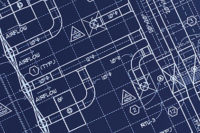An air handling unit that hasn’t worked since, well, ever. Chillers that have to work more often as a result — and an extra chiller just to attack the affected zone. These were the obvious symptoms, but what was the cause? Was economizer mode guilty, or framed? Or was it correct to paint leaky valves as the culprit? As the author demonstrates, a disproven theory just gets you one step closer to the truth.
One of my favorite stories is about when I fixed a poorly performing air handling system at a local art museum. Our goal was to renovate some office areas in one of the older sections of the museum. The facility manager was concerned that the renovation would not be successful because the AHU serving that area had never seemed to work since it was installed.
He explained that this AHU is the driving factor behind when they turn their chillers on in the spring and off in the fall. Some years they have started the chiller plant as early as March when the outside air temperature is below 45 degrees. He pointed out to me that to combat this issue, they had installed a few chilled water fan coil units to supplement the cooling loads of the spaces served by this AHU. A small air cooled chiller was installed specifically to serve these chilled water fan coil units. Other opportunities to remove load from that unit had been taken, and still it could not meet the office area cooling setpoints during all periods of operation.
The outside air duct path for this unit was long and arduous, with many transitions and fittings, so I suspected the pressure drop would be high through this ductwork. I also knew that the pressure drop of the outside air path would increase exponentially as the unit went into 100% OA economizer mode. Because of this, I suspected the supply airflow rate would drop significantly when the unit went into full economizer mode. I suggested that we take some static pressure and airflow readings in the AHU serving that area so we knew what we were dealing with. We had a TAB contractor measure the supply, return, and outside airflow rates under the two extreme conditions: minimum outside air and 100% full economizer.
THE DATA DISAGREES
Once the TAB data came in, I compared the supply airflows from when the unit was in economizer mode to when the unit was in minimum outside air mode. To my surprise, there was very little difference in the measured supply airflow between these two modes. The pressure drop through the outside air duct was high in economizer mode, but the supply airflow stayed constant because the fan curve was very steep in the area it was operating. This meant the increased pressure loss through the outside air path had very little effect on the supply flow rate, and my original theory was out the window.
The data got more interesting when I looked at the outside airflow and the supply airflow readings during economizer mode. The outside airflow was measured at 18,000 cfm while the supply airflow was 22,000 cfm. This meant that even though the return air dampers were commanded fully closed, the fan was drawing 4,000 cfm from the return air plenum. Prior to that, I hadn’t considered return air damper leakage as a cause to the issue.
When I reviewed the outside air duct static pressure in full economizer mode, I found that it was 1.5 in w.g. negative with respect to the building. In addition, the relief air plenum pressure was 1.5 in w.g. positive with respect to the building. That meant that during economizer mode, there was 3 in of pressure differential across the return air dampers. Taking this into account along with the fact that the return air dampers were 35 years old and pneumatically controlled, it made sense that there would be 4,000 cfm of leakage across these dampers.
WHAT ABOUT CONTROLS?
I then sat down with one of the facility technicians to review the unit’s controls. The most alarming thing I found was how low the supply air temperature setpoint was. They had the supply air temperature setpoint at 51°F when I would have expected to see the setpoint around 60°F. The building technician explained that they had to keep the setpoint around 50°F in order to satisfy some of the areas served by the unit. It was the low supply air temperature setpoint that was causing the need to start the chillers so early in the season and keep them on later in the fall.
I ran a mixed air calculation taking the 4,000 cfm of leakage into account and determined that the outside air temperature would need to be 46°F in order to achieve the desired 51°F discharge air temperature. This explained why this AHU needed the chillers to operate in colder weather.
The question still remained as to why the supply air temperature setpoint needed to be 51°F to keep the spaces satisfied. The system was constant volume reheat, so my next suspect was leaking control valves on the reheat coils. My next test was to take supply air temperature readings upstream and downstream of some of the reheat coils. I went to the site and tested the reheat coil valves serving the problem areas and found no temperature rise across the coils when they were commanded to full cooling. This was the second time my theory was thrown out the window.
THIRD TIME’S THE CHARM
I knew that temperature gain from the supply ductwork could be a factor, so I constructed a spreadsheet to calculate duct temperature gain. I selected one of the duct risers that served one of the problem offices and calculated what the temperature should be at specific locations so I knew what temperatures to expect when I went to the site to measure. The total length of the duct from the AHU to the supply diffuser in the office was only 90 ft, so I was very surprised by the results when my calculations showed a 9°F temperature rise from the AHU to the supply diffuser.
There were two sections of the duct branch that had the highest temperature gain. The first section with significant temperature gain was from a short section of ductwork between the discharge of the AHU to the reheat coil. I attributed this temperature rise of 1.5°F to the duct being uninsulated. The second section was the riser from the basement up to the first floor. This duct was reused from the original 1930 construction, was poorly insulated, and was oversized for the airflow it was currently balanced for. The temperature rise from this 18-ft section of 14 in x 16 in ductwork was over 4°F. The high temperature rise for this section was caused by the 135-ft/min air velocity of 210 cfm flowing through the 14 in x 16 in duct. The remaining 3.5°F of the temperature rise was attributed to the remaining branch ductwork.
I set out to measure the actual temperature rise at the duct branch and riser I had calculated. I closed the reheat coil isolation valve to ensure that heat gain from the reheat coil would not be a factor and verified the air temperature upstream and downstream of the reheat coil were the same. I then measured the discharge temperature at the AHU and systematically measured the airstream temperature in the duct path to the supply air diffuser. I was amazed at how accurate the calculated temperatures were to the measured temperature. At each location my calculations were within half of a degree of what I measured in the field. With a 51°F discharge air temperature at the unit, the supply air temperature at the diffuser was only 90 ft downstream of the AHU and just one floor above had risen to 60°F. The original 1930 duct that had been reused was responsible for almost half of the total heat gain.
I then looked at strategies for dealing with the economizer mode. My first thought was to replace the return air damper with something that had less leakage. Even a good commercial damper has 4.0 cfm/sq ft of leakage at 1.0 in wc. In addition to this, I knew the return air damper pressure differential pressure would grow when the unit was trying to pull all of its air from the outside air duct. Making the outside and relief air paths straighter was out of the question due to the location of the unit. Finally, I suspected the outside air duct was leaky and estimated that at least 10% of the air the air handler was pulling was leakage. Increasing the static pressure pull from the fan would only inflate the problem. I also knew that we wouldn’t get the duct perfectly sealed because of the limited accessibility to the majority of the duct system.
The strategy I ended up with was to install a booster fan in the outside air duct. I chose to control it with a VFD and modulate its speed based on the duct static downstream of the booster fan but immediately upstream of the AHU outside air dampers. I also made recommendations to replace the return, outside air, and relief air dampers with new dampers controlled with electronic actuators. They were never replaced because the booster fan solved the problem by itself.
I had also made recommendations to insulate all accessible supply air ductwork, which I calculated would save almost a full degree on the supply air temperature. The airflow rate to the problem areas was increased, which not only increased the cooling capacity of that zone but reduced the corresponding air temperature rise as well.
Once the booster fan was installed, AHU-9 could fully economize. The museum could now keep their chillers off further into the spring and shut them down earlier each fall. They were also able to completely abandon the roof-mounted chiller that served the chilled water fan coil units. Shortly after implementing the solutions, the museum received a check from their utility provider, which made the facility manager look like a hero to the museum curators.
TAKEAWAYS
I learned two valuable lessons on this project. The first was to not discount duct heat gain. Prior to this project, I knew how to calculate duct heat gain, but I typically assigned 1°F to it for my load calculations and never looked back. This project taught me to look at it carefully, especially when the ductwork is oversized for future capacity or when the system airflow has been reduced from its original design flow rate. The second one was keep an open mind. Don’t go into a project convinced that you know the answer and set out to prove yourself right. Sometimes, the most rewarding outcome is proving yourself wrong.






